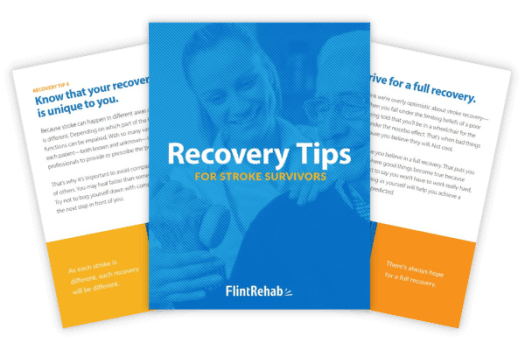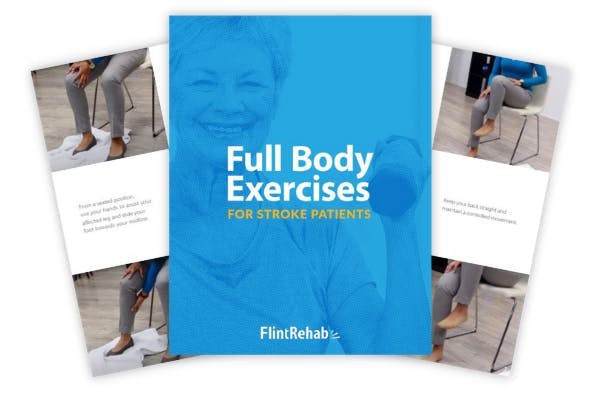No products in the cart.
No products in the cart.
No products in the cart.
No products in the cart.
Home » Neurological Recovery Blog » Stroke » Understanding a Frontal Lobe Stroke: Causes, Side Effects, and Recovery
Last updated on January 16, 2023

The frontal lobe is the largest lobe of the brain and is responsible for higher cognitive functions. This includes language, memory, problem solving, and judgment. The frontal lobe also plays a big role in our emotional expression, personalities, and movement.
Since the frontal lobe is involved in so many cognitive, emotional, and motor processes, recovery from a frontal lobe stroke can be particularly difficult. In this article we will discuss what to expect from a frontal lobe stroke and how to promote a successful recovery.
Table of Contents
Located at the front of the brain, the frontal lobe makes up over one-third of the brain’s volume and helps control many important functions. For example, the frontal lobe contains the prefrontal cortex, which is the area of the brain responsible for controlling cognition, emotional processing, and decision-making. The frontal lobe also houses the motor cortex, which initiates voluntary or purposeful movement.
To help you understand the workings of the frontal lobe, let’s summarize some of its primary functions:
Due to its involvement in so many critical functions, frontal lobe stroke can result in many secondary effects. It is important to talk with your neurologist about which hemisphere of the brain was affected by the frontal lobe stroke, as that can have implications for recovery.
There are two main types of stroke that can affect the frontal lobe (and all other areas of the brain). First, an ischemic stroke occurs when a blood clot obstructs an artery in the brain, depriving this part of the brain of oxygen. Second and less common, a hemorrhagic stroke occurs when an artery in the brain bursts, causing bleeding in the brain.
Since the frontal lobe accounts for a large portion of the brain, the chances of a frontal lobe stroke are higher than subcortical strokes that occur deep within the brain. The frontal lobe is especially susceptible to injury if there is damage to the anterior cerebral artery, or ACA.
The entire brain, including the frontal lobe, is divided into two halves. These halves are called hemispheres and are designated as left and right. Each hemisphere of the brain controls the opposite side of the body, so the left hemisphere controls the body’s right side and vice versa.
As a result, impairments usually occur on the side of the body opposite the stroke. In other words, a right frontal lobe stroke may impair movement on the left side of the body, and a left frontal lobe stroke may impair the right side.
The frontal lobe controls a wide array of functions, both motor and non-motor. When this area of the brain becomes damaged by the impact of a stroke, any of these functions can be disrupted.
Here are some of the most common secondary effects of frontal lobe stroke:
As you can see, there are many possible secondary effects following frontal lobe stroke because the frontal lobe controls a wide array of functions. Every stroke is unique, and every brain is wired a bit differently. Therefore, every frontal lobe stroke survivor will experience different secondary effects.
The good news is that the brain can heal itself after a frontal lobe stroke. Through hard work and intensive therapies, some (if not all) secondary effects can be minimized or improved.
While the effects of frontal lobe stroke can be damaging, they may not all be permanent. In fact, the brain can reassign functions to healthy portions of the brain to help “pick up the slack” and compensate for or regain lost skills.
This process is known as neuroplasticity, and it allows patients to recover, at least partially, from the secondary effects of stroke. Through massed practice, you can activate neuroplasticity and retrain your brain to recover abilities lost after frontal lobe stroke.
To understand how neuroplasticity works, think of it as paving new roads. These new roads are the neural pathways, or connections, between your brain and the rest of your body, including your muscles. The more you practice something, the stronger and more efficient these roads become.
Repetition is how all skills are originally learned when you are young — and it’s how skills are re-learned during rehabilitation from frontal lobe stroke. The more you engage in massed practice and consistently practice skills long-term, the stronger these neural pathways become and the more your function improves. Therefore, even if you’ve suffered damage to the frontal lobe, you may still be able to regain function through dedicated rehabilitation.
To regain function after frontal lobe stroke, you will need to take part in rigorous therapy and rehabilitation. Here are a few types of therapies that can promote a successful recovery from frontal lobe stroke:
It is crucial to work closely with your rehab team to develop a rehabilitation plan that is unique to you. This will allow you to work toward your specific goals, regain lost function, and recover more quickly from frontal lobe stroke.
The frontal lobe is the biggest lobe of the brain and plays a role in many different functions. Therefore, a stroke in the frontal lobe can result in a wide variety of side effects including hemiparesis or hemiplegia, cognitive deficits, ataxia, and speech-language impairments.
Fortunately, thanks to the brain’s neuroplasticity, recovery is possible. By participating in various forms of therapy, you can help rewire the brain and retrain the functions that may have been lost.
The key to recovery from frontal lobe stroke is finding therapies that fit your specific needs and goals and to prioritize consistent, repetitive practice. We hope this article helped you better understand common secondary effects following frontal lobe stroke as well as the best methods to boost recovery.

Get our free stroke recovery ebook by signing up below! It contains 15 tips every stroke survivor and caregiver must know. You’ll also receive our weekly Monday newsletter that contains 5 articles on stroke recovery. We will never sell your email address, and we never spam. That we promise.


Do you have these 25 pages of rehab exercises?
Get a free copy of our ebook Full Body Exercises for Stroke Patients. Click here to get instant access.
“My name is Monica Davis but the person who is using the FitMi is my husband, Jerry. I first came across FitMi on Facebook. I pondered it for nearly a year. In that time, he had PT, OT and Speech therapy, as well as vision therapy.
I got a little more serious about ordering the FitMi when that all ended 7 months after his stroke. I wish I hadn’t waited to order it. He enjoys it and it is quite a workout!
He loves it when he levels up and gets WOO HOOs! It is a wonderful product! His stroke has affected his left side. Quick medical attention, therapy and FitMi have helped him tremendously!”
FitMi is like your own personal therapist encouraging you to accomplish the high repetition of exercise needed to improve.
When you beat your high score or unlock a new exercise, FitMi provides a little “woo hoo!” as auditory feedback. It’s oddly satisfying and helps motivate you to keep up the great work.
In Jerry’s photo below, you can see him with the FitMi pucks below his feet for one of the leg exercises:
Many therapists recommend using FitMi at home between outpatient therapy visits and they are amazed by how much faster patients improve when using it.
It’s no surprise why over 14,000 OTs voted for FitMi as “Best of Show” at the annual AOTA conference; and why the #1 rehabilitation hospital in America, Shirley Ryan Ability Lab, uses FitMi with their patients.
This award-winning home therapy device is the perfect way to continue recovery from home. Read more stories and reviews by clicking the button below:
Grab a free rehab exercise ebook!
Sign up to receive a free PDF ebook with recovery exercises for stroke, traumatic brain injury, or spinal cord injury below: